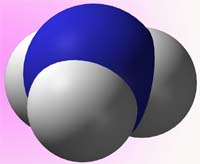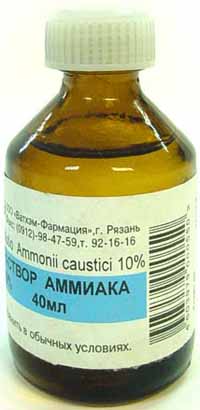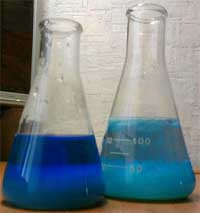
 |
AmmoniaProperties of ammonia |
 Ammonia. Aqueous solution  Reaction of copper hydroxide with ammonia Solid grease.liquid grease. Grease properties Alcohols. Properties of alcohols Resin. Phenol-formaldehyde resin
|
Ammonia is one of the most important nitrogen compounds. Nitrogen is part of proteins and nucleic acids and is one of the components that form the basis of life. Therefore, it was important to learn how to synthesize chemical compounds with nitrogen. First used electricity, but this method proved to be very expensive. A simpler way is a chemical reaction of nitrogen in the air with hydrogen to form the chemical compound ammonia! Getting ammoniaIn the industry getting of ammonia related with its synthesis from simple substances. As already noted, the source of nitrogen is air, and hydrogen is got from water.3H2 + N2 -> 2NH3 + Q The reaction of the synthesis of ammoniais reversible, therefore it is important to choose the conditions that has yield of ammonia greatest in the chemical reaction. This reaction is conducted at high pressure (15 to 100 MPa). During the reaction the volume of gases (hydrogen and nitrogen) is reduced in 2 times, so the high pressure can increase the amount of generated ammonia. Catalyst in such a reaction is sponge iron. It is interesting to note, that sponge iron acts as a catalyst only at temperatures above 5000C. But when the temperature increase the molecule of ammonia destroyed into hydrogen and nitrogen. To avoid the destruction of the molecules, when the mixture of gases passes through the sponge iron the formed ammonia immediately cool! Moreover if it a strong cool the ammonia becomes a liquid. Getting of ammonia in the laboratory, produced from a mixture of solid ammonium chloride (NH4Cl) and slaked lime. When heated ammonia intensely excreted . 2NH4Cl + Ca(OH)2 -> CaCl2 + 2NH3 + 2H2O Properties of ammonia
Ammonia at standard conditions - a gas with a pungent and unpleasant smell. Ammonia is toxic! At 20 0C 700 l of ammonia dissolves in water. The resulting solution is called the ammonia water. Because of this the solubility of ammonia can not be collected and kept over the water. Use of ammonia and its salts based on the specific properties. Ammonia is a raw material for the production of nitrogen containing substances, and as salts used as a mineral fertilizer. An aqueous solution of ammonia can be bought in pharmacies with the name of ammonia. |
Indicator pH. Color of indicator Crystal growing. How to grow crystal Color glass. The crystal. Quartz glass Complex substances. Water hardness Cooling mixture. Endothermic reaction Length unit. Units of volume. Unit weight. Units square Color of gold. Alloys of gold. Stamp of gold Food additives, conserving agents The density of substances (materials)
|